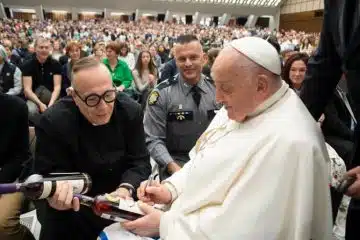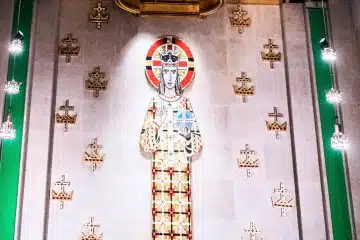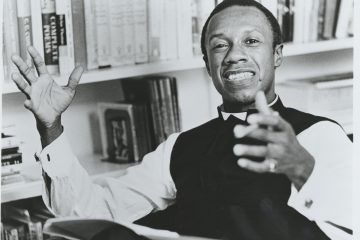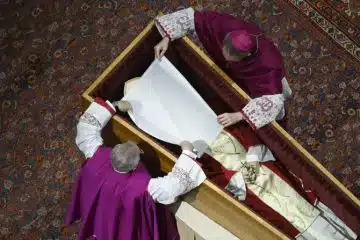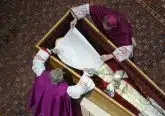Eastern churches help Catholic Church be truly catholic, bishop says

IMAGE: CNS photo/Paul Haring
By Cindy Wooden
VATICAN CITY (CNS) — In January, when Cardinal Robert Sarah, prefect of the Congregation for Divine Worship and the Sacraments, published a book supporting mandatory priestly celibacy — a book, which included an essay by retired Pope Benedict XVI — it was "painful," said Bishop John M. Botean of the Ohio-based Romanian Catholic Eparchy of St George.
The majority of Bishop Botean’s two dozen priests are married, he said, and the book seemed to question their vocations and ministry.
"The culture of married priests is still part of our culture, and our people, especially from Romania, expect it," the bishop told Catholic News Service and the National Catholic Reporter Feb. 18 during his "ad limina" visit to Rome.
The U.S. bishops’ last round of "ad limina" visits was in 2012 with Pope Benedict XVI. At that time, Bishop Botean said, the Eastern Catholic bishops requested official recognition of their churches’ tradition of married priests.
In the late 1800s, at the request of the Latin-rite bishops of the United States, who said they were worried about the confusion the practice caused, the Vatican prohibited married Ruthenian priests from living and ministering in the United States. And in 1929-30, the Congregation for Eastern Churches extended the ban to all Eastern-rite priests throughout North America, South America and Australia.
In the 1970s and 1980s, some Eastern Catholic bishops in North America sent married candidates for the priesthood to their churches’ homelands for ordination. When they returned to minister in the United States or Canada, many of them received suspension notices from the Vatican.
By the mid-1990s, some Eastern Catholic bishops were ordaining married men in Canada and the United States, and while Vatican officials continued to restate the rules against it, eventually, the suspensions stopped.
But the bishops continued to ask for respect for their churches’ traditions, including by officially allowing them to ordain married priests and to bring married priests from their homelands to minister in the United States and Canada.
The requirement of celibacy for priests in North America was "a huge, huge problem for us, and it just evaporated" in the first year of Pope Francis’ pontificate when he dropped the prohibition, Bishop Botean said.
A married priesthood is not "a panacea," he said, explaining that besides financially supporting a married priest and his family, the church also must work out assignments and transfers that consider the fact that many of the priests’ wives have careers and their children are in school.
"It’s not in the code (of canon law), but a priest’s wife has veto power" over assignments, "because you are not going to split people up or put the relationship at risk," he said.
Catholics cannot say they know their church unless they know at least something about the 23 Eastern Catholic churches that enrich the universal church with their own spiritualities, liturgies and disciplines, Bishop Botean insisted.
"A Catholic who wants to know the Catholic Church needs to know us because we are a part of it," he said.
In the United States, there are 17 eparchies — dioceses — that belong to one of nine Eastern Catholic churches: the Ukrainian, Ruthenian, Maronite, Chaldean, Melkite, Syriac, Syro-Malabar, Armenian and Romanian Catholic Churches.
Except for the two U.S. Chaldean Catholic bishops who made their "ad limina" visits with the world’s Chaldean bishops in 2018, the U.S. Eastern Catholic bishops were in Rome Feb. 16-22 for the visits, which include praying at the tombs of Sts. Peter and Paul, visiting the offices of the Roman Curia and meeting with Pope Francis.
Each wearing the liturgical vestments of his own church, the bishops were scheduled to concelebrate the Divine Liturgy according to the rites of the Syro-Malabar, Armenian, Melkite and Ukrainian Catholic churches.
While the bishops were more familiar with each other’s liturgies than most Catholics would be, they still were given booklets or sheets with all the prayers written out in English so they could concelebrate.
"You don’t have to be an Eastern Catholic to enjoy the richness" of the Eastern liturgies, Bishop Botean said, highlighting as an example the harmonized plainsong sung by four Armenian seminarians at the bishops’ liturgy Feb. 18 at the tomb of St. Peter.
Asked why the Catholic Church has so many different liturgies for celebrating the Eucharist, Bishop Botean responded, "Why do we have different languages?"
In the first centuries of Christianity — without the internet or any other reasonably quick form of communication — Christianity spread out from the Holy Land and took root in local communities with their languages and cultural expressions. Councils — first of the apostles, then of the bishops — were held to clarify the essential points of faith and doctrine, but a huge variety of religious expression flourished.
"Christianity has many forms outside of Western Christianity," Bishop Botean said. Too many people get stuck "thinking in binary, kind of ‘Catholic-Protestant’ terms," and miss the history and spirituality of the Christian East, which includes the Orthodox and Eastern Catholics.
People, including Eastern Catholics themselves, need to stop thinking of the Eastern Catholic churches as "cultural relics that somehow became appendages of the Roman church" and begin to see that they are integral parts of the Catholic Church and "instruments of the new evangelization," he said.
– – –
Copyright © 2020 Catholic News Service/U.S. Conference of Catholic Bishops. www.catholicnews.com. All rights reserved. Republishing or redistributing of CNS content, including by framing or similar means without prior permission, is prohibited. You may link to stories on our public site. This copy is for your personal, non-commercial use only. To request permission for republishing or redistributing of CNS content, please contact permissions at [email protected].


